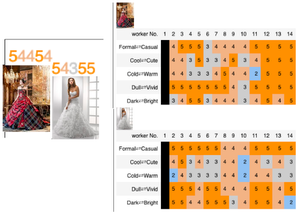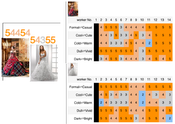Information
- Publication Type: Conference Paper
- Workgroup(s)/Project(s):
- Date: September 2020
- Lecturer: Akari Iijima
- Event: The 24th International Conference on Information Visualisation (iV2020)
- Call for Papers: Call for Paper
- Booktitle: Proceedings of the 24th International Conference on Information Visualisation (iV2020)
- Pages: 1 – 6
Abstract
The Semantic Differential (SD) Method is a rating scale to measure the semantics. Attributes of SD are constructed by collecting the responses of participant’s impres- sions of the objects expressed through Likert scales representing multiple contrasting with some adjective pairs, for example, dark and bright, formal and casual, etc. Impression evaluation can be used as an index that reflects a human subjective feelings to some extent. Impression evaluations using the SD method consist of the responses of many participants, and therefore, the individual differences in the impressions of the participants greatly affect the content of the data. In this study, we propose a visualization system to analyze three aspects of SD, objects (images), participants, and attributes defined by adjective pairs. We visualize the impression evaluation data by applying dimension reduction so that, users can discover the trends and outliers of the data, such as images that are hard to judge or participants that act unpredictably. The system firstly visualizes the attributes or color distribution of the images by applying a dimensional reduction method to the impression or RGB values of each image. Then, our approach displays the average and median of each attribute near the images. This way, we can visualize the three aspects of objects, participants and attributes on a single screen and observe the relationships between image features and user impressions / attribute space. We introduce visualization examples of our system with the dataset inviting 21 participants who performed impression evaluations with 300 clothing images.Additional Files and Images
Weblinks
BibTeX
@inproceedings{Iijima-2020-iV,
title = "Visualization of Semantic Differential Studies with a Large
Number of Images, Participants and Attributes",
author = "Akari Iijima and Takayuki Itoh and Hsiang-Yun Wu and Nicolas
Grossmann",
year = "2020",
abstract = "The Semantic Differential (SD) Method is a rating scale to
measure the semantics. Attributes of SD are constructed by
collecting the responses of participant’s impres- sions of
the objects expressed through Likert scales representing
multiple contrasting with some adjective pairs, for example,
dark and bright, formal and casual, etc. Impression
evaluation can be used as an index that reflects a human
subjective feelings to some extent. Impression evaluations
using the SD method consist of the responses of many
participants, and therefore, the individual differences in
the impressions of the participants greatly affect the
content of the data. In this study, we propose a
visualization system to analyze three aspects of SD, objects
(images), participants, and attributes defined by adjective
pairs. We visualize the impression evaluation data by
applying dimension reduction so that, users can discover the
trends and outliers of the data, such as images that are
hard to judge or participants that act unpredictably. The
system firstly visualizes the attributes or color
distribution of the images by applying a dimensional
reduction method to the impression or RGB values of each
image. Then, our approach displays the average and median of
each attribute near the images. This way, we can visualize
the three aspects of objects, participants and attributes on
a single screen and observe the relationships between image
features and user impressions / attribute space. We
introduce visualization examples of our system with the
dataset inviting 21 participants who performed impression
evaluations with 300 clothing images.",
month = sep,
event = "The 24th International Conference on Information
Visualisation (iV2020)",
booktitle = "Proceedings of the 24th International Conference on
Information Visualisation (iV2020)",
pages = "1--6",
URL = "https://www.cg.tuwien.ac.at/research/publications/2020/Iijima-2020-iV/",
}


 image
image paper
paper
